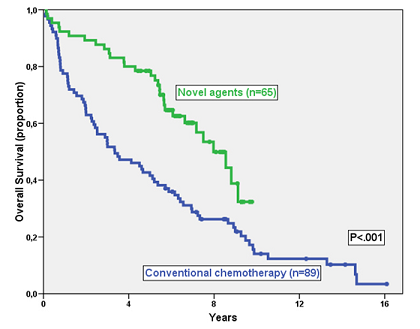FIRST LINE USE OF NOVEL AGENTS BEFORE AUTOLOGOUS SCT HAS A POSITIVE IMPACT ON TIME TO SECOND PROGRESSION AND SURVIVAL IN PATIENTS WITH NEWLY DIAGNOSED MULTIPLE MYELOMA UNDER 70 YEARS.
(Abstract release date: 05/18/17)
EHA Library. Gassiot S. 05/18/17; 182705; PB1991

Susanna Gassiot
Contributions
Contributions
Abstract
Abstract: PB1991
Type: Publication Only
Background
Most clinical trials for multiple myeloma (MM) patients using novel agent-based regimens before autologous stem cell transplantation have shown improvement in response rates and progression-free survival, however they have failed to identify a significant overall survival (OS) benefit.
Aims
Our aim is to analyze the potential impact of initial induction in the feasibility and outcome of subsequent treatment lines and other major factors affecting OS in a real clinical practice setting.
Methods
Newly MM patients less than 70 years of age diagnosed between December 1999 and December 2009 were prospectively registered. Patients were assigned to a first cohort if they received conventional chemotherapy (CC) induction regimens with new agents available at relapse or to a second cohort if received novel agents based first line treatment (NA).
Results
The overall response rate after completing first line treatment for all the 154 eligible patients was 85%, 79% in CC compared to 94% in NA (P=0.012). Very good partial response or better for NA was significantly higher than for CC (39% vs 59%, P=0.012). Patients in NA demonstrated not only a superior median progression-free survival (2.8 years vs 1.6 years, P=0.03) but also superior median progression-free survival from diagnosis to second progression – PFS2 (5.2 years vs 2.7 years, P=0.003). In both cohorts PFS1 and PFS2 represented more than 50% and 80% of life expectancy respectively. It could be hypothesized that CC patients would obtain more benefit than NA patients of second-line therapy, as they would be naïve to the novel agents used at relapse, but this is not the case. The use of thalidomide and/or bortezomib induction did not reduce the efficacy of these same agents second line. Indeed, these patients also had the best second responses that also contributed to longer PFS2 periods. After a median follow-up of 6.97 years, clear differences in OS were observed (7.97 years for NA compared to 3.35 years in CC, P<001). Despite the fact that better risk patients in the NA group were more likely to remain in first or second response, relapsed and refractory patients in this group still presented longer survivals beyond second relapse than patients in the CC group.

Conclusion
New agent based first line induction treatments in newly diagnosed MM patients provide benefits beyond first progression free survival that contribute to a significant improvement in OS.
Session topic: 14. Myeloma and other monoclonal gammopathies - Clinical
Keyword(s): Multiple Myeloma, Induction, Bone marrow transplant
Abstract: PB1991
Type: Publication Only
Background
Most clinical trials for multiple myeloma (MM) patients using novel agent-based regimens before autologous stem cell transplantation have shown improvement in response rates and progression-free survival, however they have failed to identify a significant overall survival (OS) benefit.
Aims
Our aim is to analyze the potential impact of initial induction in the feasibility and outcome of subsequent treatment lines and other major factors affecting OS in a real clinical practice setting.
Methods
Newly MM patients less than 70 years of age diagnosed between December 1999 and December 2009 were prospectively registered. Patients were assigned to a first cohort if they received conventional chemotherapy (CC) induction regimens with new agents available at relapse or to a second cohort if received novel agents based first line treatment (NA).
Results
The overall response rate after completing first line treatment for all the 154 eligible patients was 85%, 79% in CC compared to 94% in NA (P=0.012). Very good partial response or better for NA was significantly higher than for CC (39% vs 59%, P=0.012). Patients in NA demonstrated not only a superior median progression-free survival (2.8 years vs 1.6 years, P=0.03) but also superior median progression-free survival from diagnosis to second progression – PFS2 (5.2 years vs 2.7 years, P=0.003). In both cohorts PFS1 and PFS2 represented more than 50% and 80% of life expectancy respectively. It could be hypothesized that CC patients would obtain more benefit than NA patients of second-line therapy, as they would be naïve to the novel agents used at relapse, but this is not the case. The use of thalidomide and/or bortezomib induction did not reduce the efficacy of these same agents second line. Indeed, these patients also had the best second responses that also contributed to longer PFS2 periods. After a median follow-up of 6.97 years, clear differences in OS were observed (7.97 years for NA compared to 3.35 years in CC, P<001). Despite the fact that better risk patients in the NA group were more likely to remain in first or second response, relapsed and refractory patients in this group still presented longer survivals beyond second relapse than patients in the CC group.

Conclusion
New agent based first line induction treatments in newly diagnosed MM patients provide benefits beyond first progression free survival that contribute to a significant improvement in OS.
Session topic: 14. Myeloma and other monoclonal gammopathies - Clinical
Keyword(s): Multiple Myeloma, Induction, Bone marrow transplant
{{ help_message }}
{{filter}}


